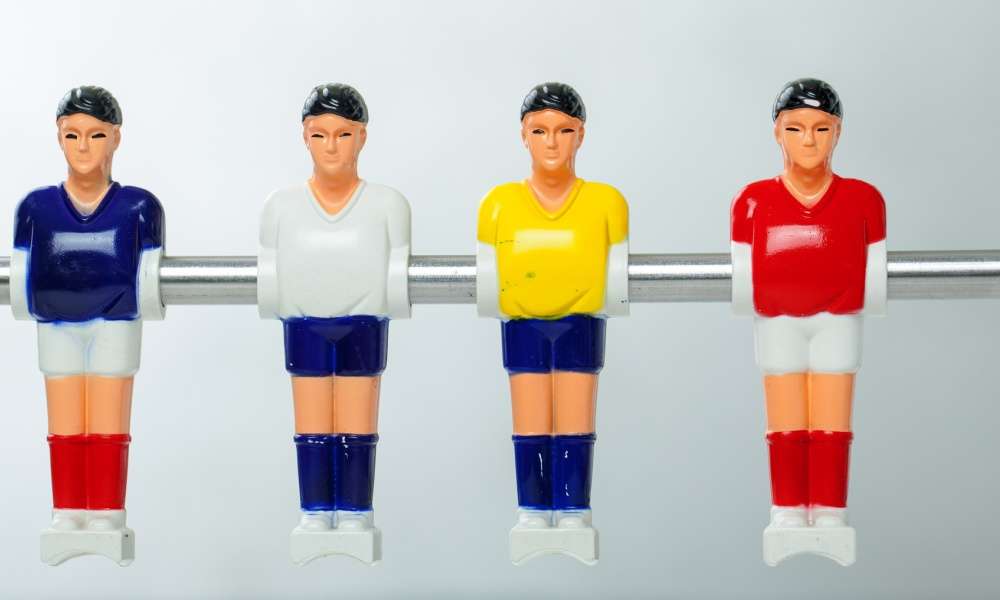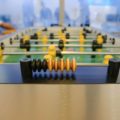
Brief History
Table soccer popularly called foosball dates back as far as 1922; when Harold Thornton conceived the idea of bringing his favourite sport to his house where he could play the game and have fun. Harold was known to be a die-hard fan of football and so he thought he could recreate a similar scene he usually sees on the football pitch right in the comfort of his home.
Harold started with match boxes and improved on this idea till he patented it in 1923 in the United Kingdom. Over the years, the game was widely accepted and in 2002, the International Table Soccer Federation (ITSF) was formed to oversee and govern the sport’s development and this metamorphosed into a competitive sport across Europe and Americas.
How it is played
Table foosball can be played by two individuals or four individuals. When it is played as four individuals (doubles), one person controls the attack while the other person controls the defence. The players are moved by a set of wooden handles to control the ball and the essence of this, just like in the game of football, is to score the opponent.
The making of a foosball table
There are basically two kinds of foosball table; the professional and home-made tables. The major difference between the two kinds are embedded in the way they are crafted and materials used for crafting, however, this belief may not be entirely true, after all, many rich people have had their foosball table customized with pure gold costing as much as $68,000. Notwithstanding, the general rule of scoring in the game applies to all.
Another difference worthy of note is the number of men on the goalie rod; some tables have only one goalkeeper, where other tables may have a defender mounted on either side of the goalkeeper.
If you are a lover of the game and you are wondering if you could make your own home-made foosball table that will equally give you the familiar feeling of the game without necessarily drilling a hole in your pocket, then you should follow the following steps in making a foosball table.
Materials
- A total of eight rods are needed with each of them having a 16mm diameter. Two rods will have two holes, another two rods will have five holes and another four rods with three holes.
- A total of eleven players in two separate colours of wood will suffice. You can choose your club’s jersey colour in order to raise the bar if you know what I mean. These woods must fit the rods with screws.
- You must also provide about sixteen synthetic bushings which have a 25 mm profile diameter and you need sixteen inner rosettes to install the bushings.
- Eight wood or synthetic grips which fit the 16mm rods that earlier provided.
- Sixteen rubber buffers or springs.
- A total of small round discs are needed. The rubber buffers will use plastics while the springs will use metal.
- For goalkeeper rods, four metal adjusting rings are required.
- The rest of the materials include; score markers for scoring, eight safety caps, the Ball, A table circular saw, a drill and Jigsaw, an eccentric sander, Rubber hammer, Clamp hook, spanner and screw driver, medium density fibre board sheets, high pressure laminate sheet. Beachwood and Plywood birch.
Instructions to follow
Row 1
Goalkeeper
1 player (could be more)
Row 2
Defence
2 players
Row 3
Opponent’s attack
3 players
Row 4
Midfield
5 players
Row 5
Opponent’s midfield
5 players
Row 6
Attack
3 players
Row 7
Opponent’s defence
2 players
Row 8
Opponent’s goalkeeper
1 player
An example of what the foosball table comprises
The first thing to do in constructing a table soccer is drawing it. Just like an architect sketches the plan and dimensions of a building he is trying to build, you might need to first make a graphical representation of what you want to build in order to build accurately.
You should draw them out on the wood so that the dimensions you need to cut are seen and ensure you cut according to aforementioned measurements.
The next thing to do is to cut the sides, legs and the body of the table that you measured out in the first step; you can now proceed to assemble the table part for your foosball table after cutting the body of the table.
It is now time to start drilling holes on the side to hold the ramps that are used for the ball. After this, you can now build the surface on the table.
You may now drill the sides. To do this, a mould is to be made using correct measurements with the diameter of the cutter case matching the holes bore on the mould.
Mount the mould to the sides by the clamp hooks and then make openings for the ball passage using a 16mm router.
You can then proceed to apply your glue your density fibre on the board and when it is dry, place the laminate sheets gently on it making sure it is firm. You can roughen up the surface with the electric sander before varnishing it.
Proceed to design and glue the penalty area and the various other important pitch markings on the playing area. Then cut out carefully the necessary marking lines. You are to make wedges in these grooves that fit perfectly and glue them into place.
You can then assemble the legs of the foosball table and then paint them. When you are sure that the legs are in place, you can then assemble the cabinet for the foosball table.
You should only attempt to build the playing field after you have cut out all the necessary components and parts. This is the most important steps in the making of a foosball table; hence, it requires a lot of patience and time. There you have your foosball table. You can give this instruction to a nearby craftsman if you wouldn’t have all the time, but it is more fun if you could make it yourself.




